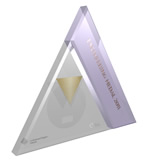
Douglas B. George, M.Eng., B.A.Sc., P.Eng
Engineer Douglas George demonstrates continuous commitment in many aspects of engineering and the sciences as an innovator, leader, administrator, and communicator. He is a gifted inventor with a remarkably astute understanding of fundamental engineering principles, who has pursued his hobby of astronomy until he has been able to incorporate it into his career. Truly passionate about the study of the universe, he shares his enthusiasm with others whenever possible. In addition to teaching a course on astronomy, he has appeared many times on radio, television, and print media. In 1989 he co-discovered Comet SkorichenkoGeorge. Since then he has co-discovered seven supernovae in distant galaxies and is also credited with co-producing one of the best time lapse movies of a comet. As an innovator, George is credited with having excelled in such engineering specialties as software design, electronics, physical measurement, and optics. He has successfully meshed his work experience with his hobby to apply the results of his expertise. Diffraction, the company George founded markets his internationally recognized image processing software for astronomical applications, MaxIm DL and MaxIm DL/CCD. Amateur and professional astronomers around the world use this software for imaging, research and discoveries. He is credited with four US and one Canadian patents as well as the development of numerous innovations relating to aircraft safety, satellite telecommunications and communications security systems. George was instrumental in developing the NavLink DSP-based helicopter navigation system, which has been installed in Canadian and US coastguard ships, as well as portable satellite telecommunication equipment. He is the co-inventor of a miniaturized micropower water-detector that has received a US patent. He redesigned the hardware used to read the Canadian Air Force CF-18 jet flight data tapes to fit into a briefcase and operate with PC instead of VAX computers. The equipment is now standard equipment at CF bases and on deployment. His ability to apply fundamental principles in engineering analysis was proven when, as chief electronics engineer in the Advanced Development division of GasTOPS, he was able to overcome seemingly insurmountable technical barriers to develop an advance failure warning sensor system for aircraft gas turbine engines. George and his co-inventor were awarded three patents for their design. Through this advanced work, aircraft safety is being enhanced, because better diagnostic capabilities on gas turbine engines give pilots early warning of potential engine failures. George has been an active member of the Royal Astronomical Society of Canada (RASC) for many years. As president from 1996 to 1998, he helped increase membership levels by 50 per cent in three years. He is credited with transforming the RASC by improving its service to members and the public, enhancing its publications, and streamlining its operations. George has not only mastered his field of engineering expertise, he has also made a measurable impact to society through sharing his knowledge. He has enriched humankind’s knowledge of the universe through his discoveries and has generously given more back to the community by teaching others about the subject that is his passion.
